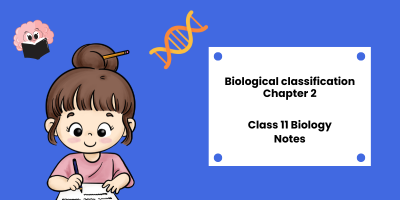Biological Classification NCERT Class 11 Biology Notes
History of Classification of Living Organisms:
Attempts to classify living organisms have been made since the dawn of civilization.
The classification was initially based on instinctive criteria for human use, such as food, shelter, and clothing.
Aristotle was the earliest to attempt a more scientific basis for classification Linnaeus developed a Two Kingdom system of classification with Plantae and Animalia kingdoms
The Two Kingdom system did not distinguish between eukaryotes and prokaryotes, unicellular and multicellular organisms, and photosynthetic and non-photosynthetic organisms
Classification systems have undergone several changes over time, with the understanding of what groups/organisms be included under each kingdom changing
R.H. Whittaker proposed a Five Kingdom Classification in 1969.
A Three-domain system has also been proposed, which divides the Kingdom Monera into two domains, leaving the remaining eukaryotic kingdoms in the third domain.
Five Kingdom Classification by R.H. Whittaker:
In 1969, R.H. Whittaker proposed a five-kingdom classification system, which includes Monera, Protista, Fungi, Plantae, and Animalia. The main criteria used for classification in this system include:
- Cell structure
- Body organization
- Mode of nutrition
- Reproduction
- Phylogenetic relationships
This system addressed some of the shortcomings of the two-kingdom system by distinguishing between prokaryotes (Monera) and eukaryotes (the other four kingdoms), as well as differentiating between unicellular and multicellular organisms and autotrophic and heterotrophic modes of nutrition.
Characteristics of the Five Kingdoms
1. Kingdom Monera:
- Cell wall: Non-cellulosic (polysaccharide + amino acid)
- Nuclear membrane: Absent
- Body organization: Cellular
- Mode of nutrition: Autotrophic (chemosynthetic and photosynthetic) and heterotrophic (saprophytic/parasitic
Bacteria are the sole members of Kingdom Monera. Grouped based on shape: coccus, bacillus, vibrio, spirilla. Exhibit extensive metabolic diversity, can be autotrophic or heterotrophic.
1.1 Archaebacteria Characteristics:
Thrive in extreme habitats:
1) Halophiles: Extreme salty areas
2) Thermoacidophiles: Hot springs
3) Methanogens: Marshy areas
Cell Wall Structure:
Unique cell wall structure distinct from other bacteria
Enables survival in extreme conditions
Methanogens:
Found in the gut of ruminant animals (e.g., cows, buffaloes)
Produce methane (biogas) from animal dung1.2 Eubacteria: Eubacteria, also known as true bacteria, are characterized by the presence of a rigid cell wall and, if motile, a flagellum. Among them, cyanobacteria, also referred to as blue-green algae, possess chlorophyll a similar to green plants and function as photosynthetic autotrophs. These bacteria can be unicellular, colonial, or filamentous and are found in various habitats including freshwater, marine, and terrestrial environments. Cyanobacteria colonies are often surrounded by a gelatinous sheath and can form blooms in polluted water bodies. Some cyanobacteria, such as Nostoc and Anabaena, have specialized cells called heterocysts for nitrogen fixation. Chemosynthetic autotrophic bacteria oxidize inorganic substances like nitrates, nitrites, and ammonia, utilizing the released energy for ATP production and playing a crucial role in nutrient recycling. Heterotrophic bacteria are the most abundant, serving as important decomposers and having significant roles in processes like curd formation, antibiotic production, and nitrogen fixation in legume roots. However, some heterotrophic bacteria are pathogenic, causing diseases such as cholera, typhoid, tetanus, and citrus canker. Bacterial reproduction primarily occurs through fission, but they can produce spores under unfavorable conditions and engage in a primitive form of sexual reproduction via DNA transfer. Mycoplasma, the smallest known living cells, completely lack a cell wall and can survive without oxygen, with many being pathogenic to animals and plants.
2. Kingdom Protista:
-
- Cell type: Eukaryotic
- Cell wall: Present in some
- Nuclear membrane: Present
- Body organization: Cellular
- Mode of nutrition: Autotrophic (photosynthetic) and heterotrophic
Protista includes all single-celled eukaryotes, although the boundaries of this kingdom are not well defined. Protista encompasses Chrysophytes, Dinoflagellates, Euglenoids, Slime molds, and Protozoans, and its members are primarily aquatic. As eukaryotes, protists have a well-defined nucleus and membrane-bound organelles, with some possessing flagella or cilia. They reproduce both asexually and sexually through processes involving cell fusion and zygote formation.
2.1 Chrysophytes
1. This group includes diatoms and golden algae (desmids)
2. Most of them are photosynthetic and found in fresh water as well as in marine environments
3. Diatoms have indestructible cell walls embedded with silica
4. Diatoms have left behind large amounts of cell wall deposits in their habitat, referred to as ‘diatomaceous earth.
2.2 Dinoflagellates1. Habitat: Mostly marine and photosynthetic.
2. Colors: Appear yellow, green, brown, blue, or red due to various pigments.
3. Cell Wall: Stiff cellulose plates on the outer surface.
4. Flagella: Two flagella; one lies longitudinally, the other transversely in a furrow between the wall plates.
5. Red Tides: Red dinoflagellates, such as Gonyaulax, can multiply rapidly, causing red tides that color the sea red.
2.3 Euglenoids
1. Habitat: Mostly freshwater organisms found in stagnant water.
2. Cell Structure: Lack a cell wall; instead, they have a protein-rich layer called a pellicle that makes their body flexible.
3. Flagella: Possess two flagella, one short and one long.
4. Photosynthesis and Feeding: Photosynthetic in sunlight, but become heterotrophic when deprived of light, feeding on smaller organisms.
5. Pigments: Pigments are identical to those in higher plants.
2.4 Slime Moulds
1. Type: Saprophytic protists.
2. Feeding: Move along decaying twigs and leaves, engulfing organic material.
3. Aggregation: Under favorable conditions, form a plasmodium that can grow and spread over several feet.
4. Reproduction: During unfavorable conditions, plasmodium forms fruiting bodies with spores at their tips.
5. Spores: Have true walls, are extremely resistant, and can survive many years under adverse conditions.
6. Dispersal: Spores are dispersed by air currents.
2.5 Protozoans
!. Protozoans: Heterotrophic, live as predators or parasites, considered primitive relatives of animals.
2. Amoeboid Protozoans: Freshwater, seawater, or moist soil. Use pseudopodia (false feet) for locomotion and capturing prey. Example: Amoeba. Marine forms may have silica shells; some, like Entamoeba, are parasitic.
3. Flagellated Protozoans: Can be free-living or parasitic. and Have flagella. Example: Trypanosoma (causes sleeping sickness).
4. Ciliated Protozoans: Aquatic. Use thousands of cilia for active movement. Water laden with food is directed into a gullet. Example: Paramecium.
5. Sporozoans: Infectious spore-like stage in the life cycle. Example: Plasmodium (causes malaria, impacting human populations significantly).
3. Kingdom Fungi: Fungi exhibit a wide range of shapes and habitats, including common mushrooms, toadstools, and parasitic fungi on plants like mustard leaves. Fungi are found in air, water, soil, and on animals and plants. and they prefer warm and humid environments.
A) Structure:
1. Filamentous: Bodies are composed of hyphae (thread-like structures).
2. Mycelium: Network of hyphae.
3. Cell Walls: Made of chitin and polysaccharides.
4.Types of Hyphae: Coenocytic (multinucleated, no septa) and septate (with cross walls)
B) Nutrition:
1. Saprophytes: Absorb nutrients from dead organic matter.
2. Parasites: Depend on living hosts.
3. Symbionts: Form mutualistic relationships, e.g., lichens (with algae) and mycorrhiza (with plant roots).
C) Reproduction:
1. Vegetative: Fragmentation: fission, and budding.
2. Asexual: Produces spores such as conidia, sporangiospores, and zoospores.
3. Sexual: Involves oospores, ascospores, and basidiospores.
D) Sexual Cycle:
1. Plasmogamy: Fusion of protoplasms.
2. Karyogamy: Fusion of nuclei.
3. Meiosis: Produces haploid spores.
Dikaryotic Stage: In some fungi (ascomycetes and basidiomycetes), a dikaryotic (n + n) stage occurs before parental nuclei fuse to form diploid.
The kingdom’s classification into different classes is based on the characteristics of the mycelium, the way spores form, and the fruiting bodies.
3.1 Phycomycetes
1. Found in aquatic environments, on decaying wood in moist and damp places, and as obligate parasites on plants.
2. Mycelium is aseptate (without septa) and coenocytic (multinucleated).
3. Reproduction:
a) Asexual: Produces spores such as zoospores (motile) and aplanospores (non-motile) within a sporangium.
b) Sexual: Forms a zygospore by the fusion of gametes, which can be isogamous (similar) or anisogamous/oogamous (dissimilar).
4.Examples: Mucor, Rhizopus(bread mould), Albugo (parasitic fungi on mustard)
3.2 Ascomycetes:
1. Commonly known as sac-fungi.
2. Mostly multicellular (e.g., Penicillium), rarely unicellular (e.g., yeast Saccharomyces).
3. Modes of nutrition: saprophytic, decomposers, parasitic, or coprophilous (growing on dung).
4. Mycelium: branched and septate.
5. Asexual reproduction: by conidia, produced exogenously on conidiophores.
6. Conidia germinate to produce mycelium.
7. Sexual reproduction: by ascospores, produced endogenously in sac-like asci (singular ascus).
8. Asci are arranged in various types of fruiting bodies called ascocarps.
9. Examples: Aspergillus, Claviceps, Neurospora.
10.Neurospora is extensively used in biochemical and genetic research.
11. Edible members include morels and truffles, considered delicacies.
3.3 Basidiomycetes
1. Commonly known forms: mushrooms, bracket fungi, puffballs.
2. Habitats: grow in soil, on logs, tree stumps, and as parasites in living plant bodies (e.g., rusts and smuts).
3. Mycelium: branched and septate.
4. Asexual reproduction: generally absent; vegetative reproduction by fragmentation is common.
5. Sex organs: absent; plasmogamy occurs through fusion of two vegetative or somatic cells of different strains or genotypes.
6. Dikaryotic structure: formed after plasmogamy, which gives rise to basidium.
7. Karyogamy and meiosis: occur in the basidium, producing four basidiospores.
8. Basidiospores: produced exogenously on the basidium (pl.: basidia).
9. Fruiting bodies: basidia are arranged in structures called basidiocarps.
10. Examples: Agaricus (mushroom), Ustilago (smut), Puccinia (rust fungus)
3.4 Deuteromycetes
1. Common Name: Imperfect fungi (deuteromycetes).
2. Identification: Known only by asexual or vegetative phases; sexual forms, when discovered, are reclassified into appropriate classes (ascomycetes or basidiomycetes).
3. Reproduction: Only by asexual spores called conidia.
4. Mycelium: Septate and branched.
5. Ecological Roles: Includes saprophytes, parasites, and decomposers aiding in mineral cycling.
6. Examples: Alternaria, Colletotrichum, Trichoderma.
4. Kingdom Plantae:
1. Includes all eukaryotic chlorophyll-containing organisms known as plants.
2. Heterotrophic Members: Some plants are partially heterotrophic, such as insectivorous plants (e.g., bladderwort, Venus flytrap) and parasites (e.g., Cuscuta).
3. Cell Structure: Plant cells have a eukaryotic structure with prominent chloroplasts and a cell wall mainly made of cellulose.
4. Major Groups: Includes algae, bryophytes, pteridophytes, gymnosperms, and angiosperms.
5. Life Cycle: Plants have a life cycle with two distinct phases:
1) Diploid Sporophytic Phase: Produces spores.
2) Haploid Gametophytic Phase: Produces gametes.
6. Alternation of Generations: The lengths and dependency of these phases vary among different plant groups.
5. Kingdom Animalia
1. Kingdom Animalia: Characterized by heterotrophic eukaryotic organisms that are multicellular.
2. Cell Structure: Cells lack cell walls.
3. Nutrition: Animals directly or indirectly depend on plants for food; their mode of nutrition is holozoic (ingestion of food).
4. Food Storage: They store food reserves as glycogen or fat.
5.Growth and Development: Follow a definite growth pattern, growing into adults with a specific shape and size.
6. Sensory and Neuromotor Mechanisms: Higher forms exhibit elaborate sensory and neuromotor mechanisms.
7. Locomotion: Most animals are capable of locomotion.
8. Reproduction: Sexual reproduction involves copulation of male and female, followed by embryological development.
6. Viruses, Viriods, Prions and Lichens
- Viruses:
- Nature: Non-cellular, inert outside a living cell.
- Replication: Take over the host cell machinery to replicate, killing the host.
- Discovery: Dmitri Ivanowsky (1892) identified viruses as causative agents of tobacco mosaic disease; M.W. Beijerinek (1898) named them “virus”.
- Structure: Composed of proteins and genetic material (RNA or DNA, but not both).
- Capsid: Protein coat made of capsomeres, arranged in helical or polyhedral forms.
- Infection Types: Plant viruses typically have single-stranded RNA; animal viruses have single or double-stranded RNA or double-stranded DNA; bacteriophages usually have double-stranded DNA.
- Diseases: Cause diseases like mumps, smallpox, herpes, influenza, and AIDS in humans; in plants, they cause symptoms like mosaic formation, leaf rolling, and stunted growth.
2. Viroids:
- Discovery: Discovered by T.O. Diener in 1971.
- Nature: Smaller than viruses, consisting of a free RNA without a protein coat.
- Disease: Cause potato spindle tuber disease.
3. Prions:
- Nature: Infectious agents consisting of abnormally folded proteins, similar in size to viruses.
- Diseases: Cause neurological diseases like bovine spongiform encephalopathy (mad cow disease) in cattle and Creutzfeldt-Jakob disease in humans.
4. Lichens:
- Nature: Symbiotic association between algae (phycobiont) and fungi (mycobiont).
- Function: Algae prepare food through photosynthesis, fungi provide shelter and absorb minerals and water.
- Pollution Indicators: Do not grow in polluted areas, indicating air quality.
Recommended Contents

Benefits of NOTES for Biological Classification NCERT Class 11 Biology Notes (CHAPTER-2)
- Comprehensive Understanding: Helps students thoroughly grasp biological classification topics.
- Exam Confidence: Enables students to confidently answer all related exam questions.
- Clear and Concise: Expert explanations are clear and concise.
- Organized Format: Notes are neatly organized with bullet points for easy reference.
- Expertly Crafted: Created by subject matter experts after thorough topic examination.
- Error-Free and Efficient: Designed for quick and effective review, ensuring no important topics are missed.



